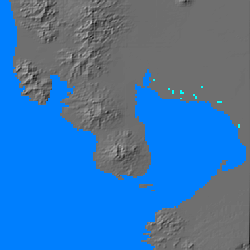![]() The Pacific War Online Encyclopedia
The Pacific War Online Encyclopedia
|
| Previous: Baruni | Table of Contents | Next: Batan_Island |

Bataan is a peninsula on the north of the
mouth of Manila Bay
in the Philippines. It
is about 40 miles (64 km) long and 18 to 25 miles (29 to 40 km)
wide.
An army that controls this peninsula controls access to the
bay. The peninsula
is mountainous, being dominated by
4222' (1287 meter) Mount Natib in the north and 4700' (1433 meter)
Mount Bataan in the south. Both mountains are actually clusters of
rugged peaks. with numerous ravines. The area between the two peaks is
a low, swampy valley. Over 75
percent of the peninsula's area of 420 square miles (1090 km2)
was densely jungle-clad,
with only two decent
roads, in 1941. This made it ideal terrain
for defense. As a result, prewar
contingency plans called
for the U.S.
forces in the Philippines to retreat into Bataan in the event of war
and
prepare to withstand a siege. However, the peninsula is one of the
worst malarial regions in the
world, and the same terrain that favored defense also made malaria
control impractical.
MacArthur
convinced the War
Department that his Philippine troops could repel the enemy at the
beach, and he
received permission to change the war plan accordingly. When
the Japanese
destroyed most of MacArthur's air power at Clark Field the
first day of the war, MacArthur was
forced to fall back on the original plan and retreat into
Bataan. However, the
changing plans meant that inadequate food,
ammunition, and other
supplies were
stockpiled in the peninsula, so that the America and Filipino troops
defending
Bataan were starving by the time the Japanese forced them to surrender. Instead, some 4500 tons of rice, 3,4 million gallons of fuel, and 500,000 artillery rounds were abandoned to the Japanese.
Bataan Campaign.
A skillful fighting withdrawal by North
Luzon Force was successful in holding the roads into Bataan long
enough for the other Allied
units on Luzon to reach the peninsula and join the defense. This was
due in part to a misapprehension by Homma, the Japanese commander,
that the Allied defense would be centered around Manila. The last American and
Filipino forces withdrew into the
peninsula
on 5 January 1942. By 9 January
1942 Homma had regrouped and launched an attack against Bataan
defenses. Although the American line on the
western
side of the peninsula held, the eastern line was penetrated, and by 24
January the Americans were forced back to their second defense line. Japanese casualties were considerable.
Homma called for reinforcements while continuing to
probe the Allied lines. On the night of 22-23 January 1942 the Japanese
landed in battalion strength from barges at points on the southwest
coast of Bataan. Additional reinforcements landed on 26-27 January and
1-2 February, but thereafter American PT boats and improvised
patrol boats ("Mickey Mouse battleships") blocked further reinforcement
by barge, and the Japanese beachheads were eliminated in the Battle of
the Points.
On 3 April 1942 Homma launched a second major offensive against the starved and weakened Allies, which broke the second defense line almost at once and forced the Allied commander on Bataan, King, to surrender on 9 April 1942.
The Death March. With the Japanese' own logistics on the verge of collapse, the starving Allied prisoners would likely have had a hard time even if the Japanese had treated them correctly. The Japanese did not. The forced march of the 75,000 sick and starving Allied prisoners of war to their camps in central Luzon was marked by such brutality that it became known to history as the Bataan Death March. Thousands of prisoners were executed or died of mistreatment during the march, making this the single greatest atrocity committed against American troops during the war. An estimated 600 Americans and 5000 to 10,000 Filipinos died during the march. Though this atrocity was not comparable in scope to the rape of Nanking or the slave labor camps on the Bangkok-Moulmein railway construction route, it is probably the Japanese atrocity most familiar to Americans today.
The single worst incident during the Death March was the massacre of approximately 400 Filipino commissioned and noncommissioned officers of 91 Philippine Division at the Pantingan River. The officers were first separated from the private soldiers, who were marched away and spared from the massacre. A Japanese interpreter then told the remaining prisoners (Norman and Norman 2009):
Dear friends, pardon us. If you surrendered early, we would not be killing you. But we suffered heavy casualties. So just pardon us. If you have any last wish before we kill you, just tell us.
The prisoners were then shot, bayoneted, or beheaded. Some four prisoners, badly wounded, survived by playing dead, then escaping into the hills after the Japanese had left. These witnesses later identified Nara Akira as the general responsible for ordering the massacre.
Word of the Death March was slow to reach the Western
Allies. An accurate picture was not available until June 1943, when
William Dyess, Melvin McCoy, and Stephen Melnick escaped from the
Japanese and were spirited out to Australia by famed guerrilla organizer "Chick" Parsons. So shocking were their reports that they were kept from the press until mid-1944 for fear of retaliation against Americans still held prisoner.
References
The Pacific War Online Encyclopedia © 2006, 2008-2011, 2013-2014 by Kent G. Budge. Index